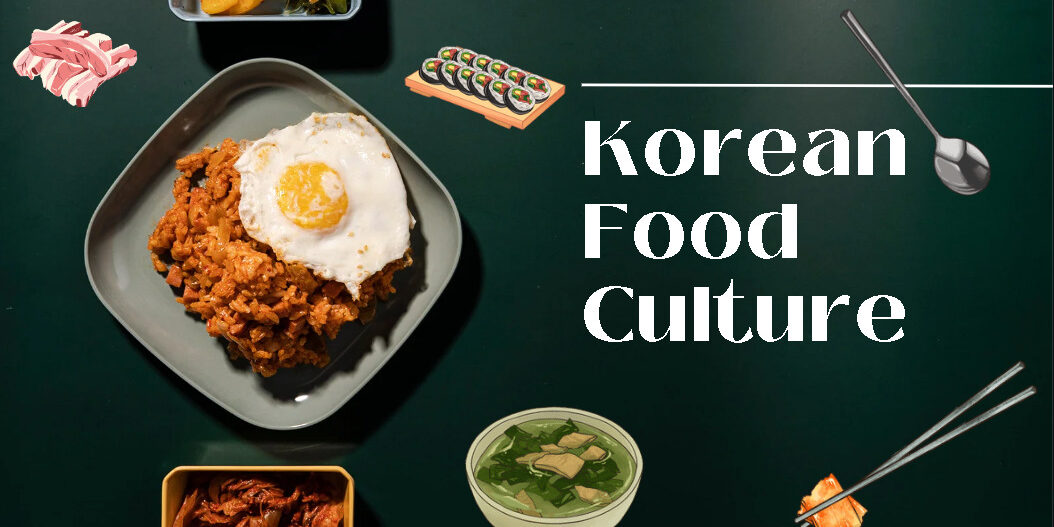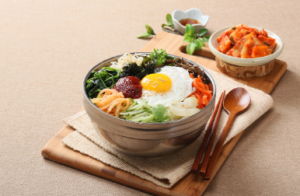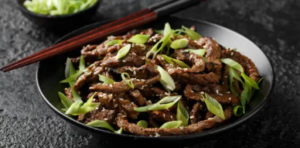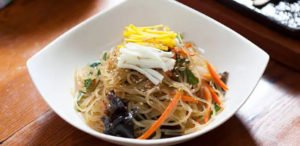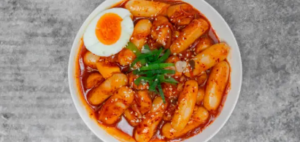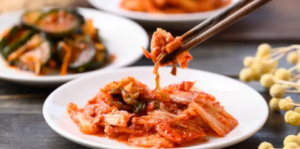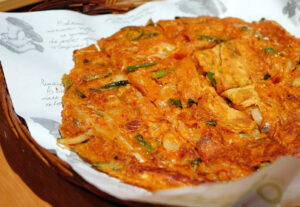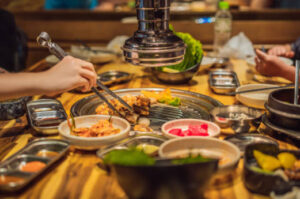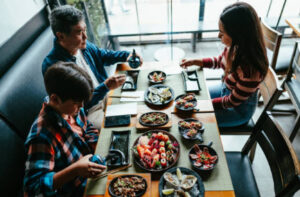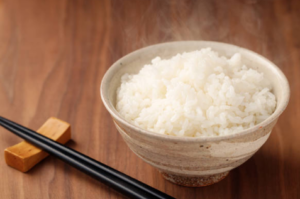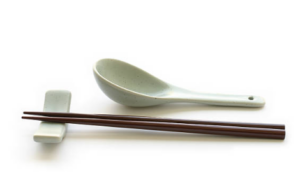Let’s learn about Korean Food Culture !
Korean cuisine, Hansik, is defined by its clear separation of main dishes like rice or noodles from side dishes known as banchan. It boasts a rich variety of recipes, blending animal and plant-based ingredients in balanced harmony. Particularly notable are the meticulously crafted fermented foods, reflecting a tradition of patient preparation. Additionally, Korean culture holds the belief that food and medicine are interconnected, encapsulated in the saying, “food is the best medicine.”
Here are a few food you could find during a traditional Korean Meal as well as some tips if you get invited to one !
Main dishes :
- Bibimbap:
Bibimbap is a signature Korean dish renowned for its vibrant colors, flavors, and textures. It typically consists of steamed rice topped with an array of seasoned vegetables, sliced meat (often beef), a fried egg, and spicy gochujang (red chili paste) or soy sauce. The ingredients are arranged in a visually appealing manner, and diners mix them together before eating.
- Bulgogi:
Bulgogi is a classic Korean dish featuring thinly sliced marinated beef that’s grilled or stir-fried to perfection. The marinade typically includes a blend of soy sauce, sugar, sesame oil, garlic, and pepper, imparting a sweet and savory flavor profile with a hint of smokiness. Bulgogi is known for its tender texture and rich, caramelized exterior. It’s often enjoyed with rice and lettuce leaves for wrapping, along with various accompaniments like kimchi and ssamjang (spicy paste).
- Japchae:
Japchae is a popular Korean dish made with stir-fried glass noodles (typically made from sweet potato starch) and an assortment of vegetables, often including carrots, spinach, mushrooms, and onions. It may also contain thinly sliced beef or other proteins. The noodles are seasoned with a mixture of soy sauce, sesame oil, garlic, and sugar, creating a savory and slightly sweet flavor profile.
- Rice Cake:
Rice cakes, or “tteok” in Korean, are a versatile staple of Korean cuisine made from glutinous rice flour. They come in various shapes and textures, often used in celebratory dishes or enjoyed as snacks or desserts. Tteok symbolize prosperity and are a significant part of Korean culture.
Side dishes :
- Kimchi:
Kimchi is a spicy, tangy Korean dish made from fermented vegetables like cabbage and radishes, seasoned with chili, garlic, and other spices.
- Jeon:
Jeon is a Korean style pancake made from a batter of flour, eggs, and water, mixed with various ingredients like vegetables, seafood, or meat. It’s then pan-fried until crispy on the outside and served with dipping sauces. Jeon is popular as a savory snack or appetizer in Korean cuisine.
- Gui:
Gui is Korean grilled dishes, where meats, seafood, or vegetables are marinated and cooked over an open flame or barbecue, offering savory flavors.
Korean Table Manners :
- The first person to eat:
In Korean dining etiquette, it’s customary to allow the oldest person at the table to start eating before beginning your meal. This tradition underscores the importance of age hierarchy in Korean culture. Asking someone’s age early on serves as a way to gauge their place in this hierarchy, ensuring respectful interaction and avoiding discomfort.
- Matching the speed:
In Korean dining customs, it’s important to match the pace of those around you. If you notice you’ll finish before others, consider slowing down to avoid giving the impression of rushing. Conversely, if others are nearly done and you’ve barely started, it’s time to dig in. Eating too quickly may imply impatience, while eating too slowly could suggest disinterest in the meal.
- No lifting :
In South Korea, it’s customary to keep your soup or rice bowl on the table while eating, unlike in other Asian cultures where lifting it is common. Korean dining etiquette emphasizes using a spoon to eat rice instead of chopsticks and maintaining the bowl’s position throughout the meal.
- Chopsticks etiquette:
To dine gracefully in Korea, hold your spoon and chopsticks in separate hands and use only one utensil at a time to minimize spills. Avoid inserting chopsticks directly into your rice bowl, as it’s reminiscent of funeral ceremonies, considered impolite, and can be distracting. Instead, place chopsticks on the bowl’s edge or on a designated rest provided.
Korean food culture is characterized by its diverse array of flavorful dishes, including staples like kimchi, jeon, gui, and anju. It emphasizes the use of fresh ingredients, bold flavors, and communal dining experiences. Korean cuisine reflects a rich culinary heritage that has evolved over centuries, blending tradition with innovation to create a unique and dynamic food culture enjoyed worldwide. So ready to try it?
By Tya BERAMICE-DRACAN

